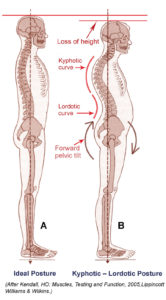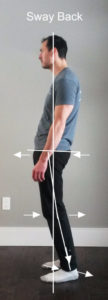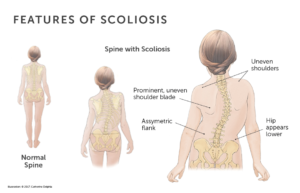If you’ve ever observe people walking, sitting or even standing in an awkward manner then you understand what “poor posture” means. Many people don’t realize that poor posture affects more than just your appearance while standing up or sitting down, it also has an effect on your physical and mental well-being. Your spine is the main structure in your body and having it misaligned can lead to bigger problems in your health and how your body functions in daily life than just laziness and discomfort.
There are many reasons why people have bad posture. It could be a result of compensations that occurred due to disease, movement patterns or after injuries. For others, such problems could be inborn, but in most cases, not having good posture could be due to the position you take as part of your lifestyle or occupation. Some movements that you repetitively doing every day.
A Few Types of Common Postures
Kyphosis / Lordosis
 This is one of the most common types of bad postures if you are spending most day sitting. This could be related to most of us as we sit in the car on the way to and from work, sit at the desk at work, sit at the computer, sit on a couch while relaxing after work, etc. In this posture you stand with your upper back curved (over flexed which is called “kyphosis”), your head is forward and your shoulders are rounded forward as well. Sometimes you can have a deep curve at low back (over extended, which is called “lordosis”).
This is one of the most common types of bad postures if you are spending most day sitting. This could be related to most of us as we sit in the car on the way to and from work, sit at the desk at work, sit at the computer, sit on a couch while relaxing after work, etc. In this posture you stand with your upper back curved (over flexed which is called “kyphosis”), your head is forward and your shoulders are rounded forward as well. Sometimes you can have a deep curve at low back (over extended, which is called “lordosis”).
This posture puts a lot of pressure on your back and neck which leads to weak muscles in your upper back and abdomen, tight low back and a lot of tension in neck. This is what causes back pain and discomfort because it weakens the muscles designed to help you stand or sit in the right position against gravity, so your body can move functionally.
Sway Back
In this posture your torso is not sitting on top of your pelvis, it’s a bit behind as your hips are swayed forward, shoulders are rounded forward. Your spine curve at low back is usually flattened and hip flexors are elongated. This posture puts a lot of weight on the midsection and is common for individuals who spend a lot of time standing. As a result the weight is unevenly distributes on your spine and other joints and this causes stress and strain on joints or muscle tension is certain areas of your body which end up causing pain. 
Flat Back
A Flat Back posture type describes itself in its name. It looks similar to Sway Back posture type, but there is no misalignment between the upper and lower body, meaning that your trunk sits right on top of your pelvis. In this posture abdominal muscles are usually weak, especially obliques and pelvic floor. Because of muscular imbalances during movement and compensations mainly in the lower body (hips and legs) people usually feel discomfort in low back, knees or hips.
Can you imagine walking or running with this posture for a long time? What do you think will happen? Because of weight distribution and the gravity force, there will be a lot of pressure on knees and ankles and in the long run, it will cause some type of injury.
Scoliosis
 Scoliosis is the sideways curvature or abnormal twisting of the spine. The curve is usually “S”- or “C”-shaped over three dimensions. Someone with this posture might also have uneven hip height or shoulder. Most common signs of scoliosis include:
Scoliosis is the sideways curvature or abnormal twisting of the spine. The curve is usually “S”- or “C”-shaped over three dimensions. Someone with this posture might also have uneven hip height or shoulder. Most common signs of scoliosis include:
- Uneven shoulders
- One shoulder blade that appears more prominent than the other
- Uneven waist
- One hip higher than the other
If a scoliosis curve gets worse, the spine will also rotate or twist, in addition to curving side to side. This causes the ribs on one side of the body to stick out farther than on the other side. This is a common posture for those in the production line as they constantly have to twist or lean in one direction.
Long-Term Effects of Bad Posture
The human body is designed to stand strong and straight with the ankle, knee, hip and shoulder bones stacked in a vertical line. With poor posture, the surrounding muscles become overworked. Other muscle groups try to compensate for the imbalances which cause tension to build in the lower back, neck, shoulders, and hips. That tension not only triggers painful knots and spasms but also places you at a much higher risk of injury and more serious conditions. Good posture helps to prevent tension from building up in the first place and reduces the risk of more serious complications down the road.
Stress on the Spine from Sitting
Sitting is an unnatural position that forces the spine and surrounding muscles to compress and tighten. The longer you hold that position, the more difficult it becomes to release the pressure and realign the spine to its proper curves. This leads to chronic back pain, tension headaches, and degradation of the tissues surrounding your joints.
Spinal Degeneration
If steps aren’t taken to correct bad posture, the spine will start to deteriorate if misaligned for too long. This could lead to harmful conditions that will impact your ability to perform daily routines. These conditions include unnatural spinal curvature, inflammation, nerve damage, herniated discs, formation of bone spurs, weakness in the limbs, and pain in areas unrelated to the spine.
Negative Mood
Recent studies show that people who slouch have increased feelings of depression and fatigue. This is due to the body having to work harder to hold you upright, which drains your energy and mood. Even our language reflects this connection between proper posture and emotional effect, for example, we call someone weak as “spineless” and someone who is proud or confident we say he or she has a “backbone”.
How to Fix Bad Posture
There are two most common ways to fix a bad posture: mechanical or functional. Each type has its own benefits and knowing that usually a combination approach works best, I would say that functional way is what Pilates uses and it is much better for your long term wellness. Let’s take a look what they are in details.
Mechanical approach is focused on using an external force to align primarily bony or skeletal structure in an optimal way. You can use practitioner or tool/device to achieve so. Some of the practitioners who can help you are chiropractors, physio therapists and osteopath. You can experience benefits fairly quickly (depending on how long you had that type of posture) and ease some muscle tension that is associated with your body misalignment.
Some of the devices or tools that you can use are neck wedge, wearable back brace or posture corrector or a foam roller. These are easy to buy (from your local Walmart store or Amazon) and they are obviously less expensive to invest, plus you can use them for a while. Some disadvantages using these props are that they often target only one are of the spine. Like neck wedge will be used to ease neck tension working to restore primarily cervical spine. A lot of wearable back posture correctors are targeting only upper mid-back (kyphosis), but not low back (lordosis or sway back types of posture).
Pros of mechanical approach is that you can address muscle tension or tightness fairly quickly either with a qualified practitioner or a prop. Cons are that it is a short term approach and you will always need to go back to the practitioner or using a device. The changes are made primarily to the bony structure and if you continue with your current lifestyle and inefficient movement patterns you will end up with your bad posture again. This is because all the muscular system that supports your skeletal structure is not being changed or balanced to support ideal posture. So you can reverse all the benefits of this type of therapy easily.
Functional approach is primarily focused on changing how your body engaging different muscle groups during movement and in everyday life. Guess what, it involves exercises that fire up proper muscular systems and reduce the amount of compensations in your body, thus, reduce muscle tightness and imbalance. It also uses stretching techniques to elongate muscles that are picking up the work load more often and becoming tight. It is more of internal approach to train your body to do the movements in more efficient and functional way and that’s why it will help you to improve your posture for a long-term. That’s what Pilates approach is offering and I’ve seen great results for myself and other clients that I worked with.
Just to reiterate, Pros of this approach is that is teaches your body to maintain a better posture by using muscular system to support better movement patterns. You can learn more about how your body moves and the results will stay long-term. Cons are in finding an exercise program that is targeted to your posture and work with qualified Pilates instructor to monitor your progress. It may take a little while to learn and discover how your own body is moving, and being aware of your daily movement patterns, aka mind-body connection. I think in the long term this method is way more beneficial than other ones.
References:
https://www.mayoclinic.org/diseases-conditions/scoliosis/symptoms-causes/syc-20350716

Awesome post! Keep up the great work! 🙂
Great content! Super high-quality! Keep it up! 🙂
Excellent blog here! Also your web site loads up fast!
What host are you using? Can I get your affiliate link to
your host? I wish my web site loaded up as quickly as yours lol
P.S. If you have a minute, would love your feedback on my new
website
re-design. You can find it by searching for «royal cbd» — no sweat if
you can’t.
Keep up the good work!
I couldn’t refrain from commenting. Very well written!
Very descriptive blog, I liked that bit. Will
there be a part 2?
What exactly are you interested in learning about?
I have to thank you for the efforts you’ve put in penning this blog.
I am hoping to check out the same high-grade content by
you later on as well. In fact, your creative writing abilities has inspired me to
get my very own blog now 😉
Hello there. I found your site by means of Google while looking for a similar matter, your site got here up. It looks great. I have bookmarked it in my google bookmarks to visit then.
Hi there would you mind stating which blog platform
you’re using? I’m planning to start my own blog soon but I’m having a hard time
deciding between BlogEngine/Wordpress/B2evolution and Drupal.
The reason I ask is because your design and style seems different then most
blogs and I’m looking for something unique.
P.S Sorry for getting off-topic but I had to ask!
Hi, I’m using a WordPress engine and it’s working well for me. You definitely can research other options and see what would work best for you.
Thanks a lot for the post.Really thank you! Much obliged.cheap cialis
I’ve been browsing online more than 3 hours nowadays, yet I never found any interesting article
like yours. It’s beautiful value sufficient for me. In my opinion, if all website owners and bloggers made good content
as you did, the web might be a lot more helpful than ever
before.
Also visit my web blog Milford
I have been exploring for a little for any high-quality articles or blog posts on this sort of area . Exploring in Yahoo I at last stumbled upon this website. Reading this info So i’m happy to convey that I have an incredibly good uncanny feeling I discovered just what I needed. I most certainly will make certain to don’t forget this web site and give it a look regularly.
i like this terrific post
Greetings from Idaho! I’m bored to death at work so I decided to browse your website on my iphone during lunch break. I love the knowledge you present here and can’t wait to take a look when I get home. I’m amazed at how fast your blog loaded on my phone .. I’m not even using WIFI, just 3G .. Anyhow, amazing blog!
I am continually searching online for articles that can facilitate me. Thx!
It’s perfect time to make a few plans for the longer term and
it’s time to be happy. I have read this submit and if I may just I desire to suggest you few attention-grabbing things or suggestions.
Perhaps you can write next articles regarding this article.
I want to learn more things approximately it!
You actually make it seem so easy with your presentation but I find this topic to be really something that I
think I would never understand. It seems too complex and extremely broad for me.
I am looking forward for your next post, I’ll try to get the hang of it!
It’s going to be end of mine day, except before ending I am reading this impressive post to increase my experience.
Its such as you learn my thoughts! You appear to understand so much about this, like you wrote the e-book in it or something.
I believe that you could do with some p.c. to power the message home
a little bit, but other than that, that is great
blog. A great read. I will certainly be back.